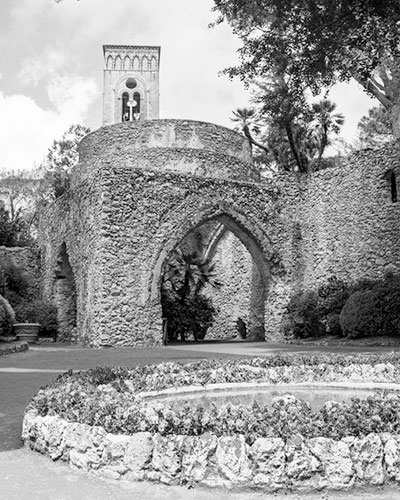
ABOUT
KUNDRY
IN RAVELLO
How the magic begins
Kundry is one of the principle characters in PARSIFAL, the dramatic-sacred opera composed by Richard Wagner between 1857 and 1882. It is here in Ravello that in 1880 during a brief visit to the town and whist admiring the beautiful garden of Villa Rufolo, the German composer drew his inspiration for the setting of the second scene of the second act for the drama. At the sight of colourful flowers, exotic foliage, pines, cypresses and other fine floral species and picturing it as the perfect backdrop for the scene for Kundry’s deceitful kiss, he exclaimed:
“THE MAGIC GARDEN OF KLINGSOR HAS BEEN FOUND”
Kundry is a wild horsewoman, a mysterious woman, bewitching and seductive. This Wagner character represents temptation, “the body of sin”, who the evil magician Klingsor uses to prevent Parsifal from saving the “Grail Kingdom”.
Right in the second act, when the scene takes place in the enchanted garden (inspired by Villa Rufolo), Parsifal is drawn into Klingsor’s kingdom and is encircled by flowers-maidens as well as the beautiful Kundry, but in order to remain pure, he resists the temptation to be kissed by the woman.
However, in the third act Kundry epitomises Mary Magdalene, the sinful adulteress who was later saved by Jesus: in fact just like Mary Madalene, Kundry brings an ampoule of balm (reminiscent of the Grail) which she uses to wash Parsifal’s feet before drying them with her long hair. Then Parsifal baptises Kundry and she dies redeemed.
Kundry is a woman polarised, struggling between good and evil, between deception and truth, between sin and redemption, but eventually she manages to rise up to a better life by atoning her sins. A woman to be understood, to be followed, to be admired…a woman living.
ABOUT
KUNDRY
IN RAVELLO
Kundry is one of the principle characters in PARSIFAL, the dramatic-sacred opera composed by Richard Wagner between 1857 and 1882. It is here in Ravello that in 1880 during a brief visit to the town and whist admiring the beautiful garden of Villa Rufolo, the German composer drew his inspiration for the setting of the second scene of the second act for the drama. At the sight of colourful flowers, exotic foliage, pines, cypresses and other fine floral species and picturing it as the perfect backdrop for the scene for Kundry’s deceitful kiss, he exclaimed:





Kundry is a wild horsewoman, a mysterious woman, bewitching and seductive. This Wagner character represents temptation, “the body of sin”, who the evil magician Klingsor uses to prevent Parsifal from saving the “Grail Kingdom”.
Right in the second act, when the scene takes place in the enchanted garden (inspired by Villa Rufolo), Parsifal is drawn into Klingsor’s kingdom and is encircled by flowers-maidens as well as the beautiful Kundry, but in order to remain pure, he resists the temptation to be kissed by the woman.
However, in the third act Kundry epitomises Mary Magdalene, the sinful adulteress who was later saved by Jesus: in fact just like Mary Madalene, Kundry brings an ampoule of balm (reminiscent of the Grail) which she uses to wash Parsifal’s feet before drying them with her long hair. Then Parsifal baptises Kundry and she dies redeemed.
Kundry is a woman polarised, struggling between good and evil, between deception and truth, between sin and redemption, but eventually she manages to rise up to a better life by atoning her sins. A woman to be understood, to be followed, to be admired…a woman living.
Do not stop discovering Kundry's world
Please find out below our magical world.
Do not stop discovering Kundry's world
Please find out below our magical world.
